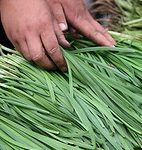As global food prices continue to soar, biotechnology firms and advocates are lining up to argue that gene technology can solve the world’s food shortages.
China, too, has ambitions in the research and application of genetically modified (GM) crops. Government plans for the industry include the development of pest- and disease-resistant GM rice, rapeseed, maize and soy. Development of new GM crops is one of the 16 major projects listed in the country’s plan for mid- to long-term scientific and technological development (from 2006 to 2020). It will be China’s most expensive agricultural science undertaking of all time, with research focussing on yields, quality, nutritional value and drought-resistance.
So, can GM crops actually increase food production?
GM technology transplants novel genes into an organism in order to improve it in some way. In GM crops that are already being tested or commercially farmed, genes have been added to increase resistance to pests, disease and herbicides – but never to directly increase harvests.
However, these changes can – at least in theory – increase yields. This is the viewpoint taken by the International Service for the Acquisition of Agri-biotech Applications’ (ISAAA) 2007 report, Global Status of Commercialized Biotech/GM Crops, which says GM technology can increase production.
In India and China, fields of pest-resistant GM cotton need 50% less pesticide than non-GM strains. The technology has been responsible for harvest increases of 50% in India and 10% in China. The GM strain has an additional gene – known as Bt, for the Bacillus thuringiensis bacteria from which it originates – which produces a poison that kills off certain pests that attack cotton plants.
Cotton is not a food crop, but some argue that the same technology could also be used to increase maize production. In South Africa, Richard Sithole, chair of the Hlabisa District Farmers’ Union, reported that 250 poor, small-scale farmers planted GM maize with the Bt gene on their plots, which averaged at 2.5 hectares per household. His own harvests rose by 25%, worth an extra US$300, and some farmers reportedly saw increases of 40%.
Among all modified food crops, it is GM rice that is drawing the most attention. In China alone there are 110 million rice farmers, with an average 0.27 hectares of land per capita. The impact of increased harvests would be massive.
Iran is the only country to have approved the commercial growing of GM rice. But China has spent significant amounts on researching this area. Four pest-resistant strains have passed intermediary testing and environmental release trials, and are now undergoing large-scale planting trials – the forerunner of commercial use.
A research team led by Huang Jikun, head of the Centre for Agricultural Policy at the Chinese Academy of Sciences, carried out a survey of pre-production trials on two strains of pest-resistant rice. The ISAAA quoted this study as saying the strains could increase yields by between 2% and 6%, and reduce the use of pesticides by almost 80%.
However, a paper by Huang’s research group, published earlier this year in the journal Economic Development and Cultural Change, revised this claim. The villages where GM rice was planted did see an increase in harvests, they said, but households where both GM and non-GM rice were planted did not see any improvement. They say there is no evidence from randomised and controlled trials that GM rice does increase harvests.
One reason may be that the trials were not actually randomised; village officials may have chosen better farmers to participate in the tests. Whatever the reason, more research is needed before to ascertain whether pest-resistant rice increases yields or not. Even if it does not increase yields, but does reduce pesticide use and labour input – while presenting no health or environmental risks – then it will help to slow the rising cost of food.
There also may be a new hope for the use of GM rice to raise yields, as reported in a paper by Zhang Qifa and his research group at Huazhong Agricultural University, published in May 2008 issue of Nature Genetics. The research group discovered for the first time a single gene that controls stalk height, flowering time and the number and size of grains. Theoretically, this gene can be used to increase productivity. For now, however, this possibility only exists on paper.
Debate rages over the use of GM technology in other food crops besides rice. Some research has found that GM technology actually can result in smaller harvests. A recent study by Barney Gordon of Kansas University, published in Better Crops, found that yields from a Monsanto-produced strain of herbicide-resistant soy were 10% lower than from conventional varieties.
The International Assessment of Agricultural Knowledge, Science and Technology for Development (IAASTD), which was produced by 400 experts from around the world over a period of three years, reflects this controversy. Limited research data on some GM crops in certain years show increased yields of 10% to 33%, while others see lower harvests. The report, therefore, makes a cautious assessment on whether GM crops can meet the increased demand for food. With GM technology developing rapidly, it says, long-term evaluations of the risks and benefits for health, the environment and the economy are lagging behind.
The IAASTD report has been accepted by 57 nations, including China. The Daily Telegraph, a British newspaper, interpreted the report as saying that GM technology did not offer a solution to food shortages. However, the IAASTD did not entirely reject the idea that GM has a role to play, but warned against over-simplifying the problem or relying too heavily on GM crops. A multi-pronged approach is needed, the report said, including further agricultural research and the continuation of local agricultural practices. It also warned that patents on GM technology can have negative effects, such as obstructing independent scientific research and the freedom of small farmers to make their own choices.
In truth, it is wise neither to simply advocate GM technology nor to oppose it entirely.
The technology is already becoming one of the major characteristics of modern agriculture. As it develops, we need independent and objective research, the prompt and full release of information and the participation of all stakeholders.
To discover whether GM crops really can increase yields, we may need to copy the randomised controlled trials that are used in medical research and carry out analysis of actual case studies. Only then will we have a convincing answer.
Li Taige is a Beijing-based journalist. He obtained a master’s degree in engineering from Sichuan University in 1997, and studied as a Knight Science Journalism Fellow at the Massachusetts Institute of Technology (MIT) in 2003-2004.
Homepage photo by CaptPiper




